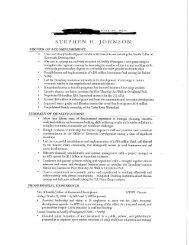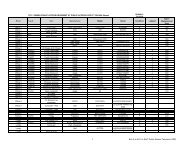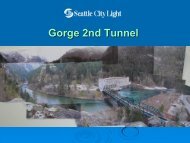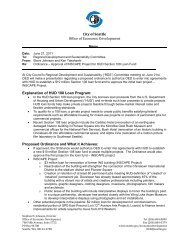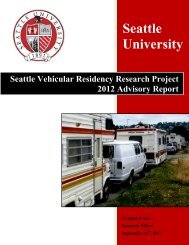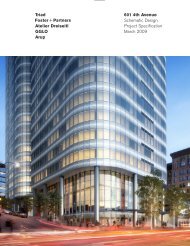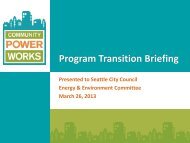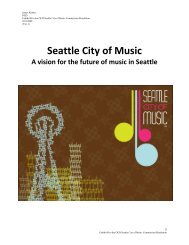2013 Water System Plan, Volume II - Seattle City Clerk's Office - City ...
2013 Water System Plan, Volume II - Seattle City Clerk's Office - City ...
2013 Water System Plan, Volume II - Seattle City Clerk's Office - City ...
Create successful ePaper yourself
Turn your PDF publications into a flip-book with our unique Google optimized e-Paper software.
Chapter 5 <strong>Water</strong> Infrastructure<br />
are required by other entities (e.g. railroads) where SPU utilities cross over or under them.<br />
Casings can be installed via open cut if there are no obstacles.<br />
Casing materials must follow Standard Specifications 9-30.2 (14) and 9-30.2(15).<br />
A. Jacked Casings<br />
Casings installed under the railroad are often jacked into place. When designing jacked<br />
casings, adequate space is required for the casing and pipe jacking pit. Jacking pit size<br />
can vary depending on the lengths of casing or pipe. Restrained joint pipe must be used<br />
through the casing and beyond to a logical location to terminate the restrained joint<br />
pipe. Keep in mind that the cased length of pipe offers no thrust resistance via skin<br />
friction as does a buried pipe. Access must be provided for the pipe to be cut and<br />
connected to a new pipe. SPU preference is to have the jacking pit located on each side<br />
of the casing.<br />
Note:<br />
Jacking casing is dependent on pipe size. The larger the pipe size, the larger the<br />
jacking pit is. Keep the casing as far as practical from the other utilities to allow future<br />
access for pipe removal.<br />
B. Other Utility Crossings<br />
The design engineer must determine where casings are needed at locations where an SPU<br />
transmission main is crossing either over or under other utilities. For separation requirements<br />
between water mains and other utilities, see Standard <strong>Plan</strong>s 286A and 286B. All pipes in casings<br />
must be restrained joint. See Standard Specifications 7-11 3(6)D and 7-11.3(7)C-D2.<br />
C. Railroad Crossings<br />
Where water mains cross under a rail system (e.g. street car, light or heavy rail, or other<br />
as determined by SPU), the main must be placed inside a casing. The casing must extend<br />
such a distance from the tracks that maintenance can be performed from the side<br />
without affecting the rail. For cathodic protection for pipes crossing a rail line, see DSG<br />
Chapter 6, Cathodic Protection, Test Procedure (TP) 31 – Light Rail and Street Car<br />
Cooperative Interference Testing.<br />
i<br />
Heavy Rail<br />
When crossing beneath heavy rail, a casing must extend from ROW line to ROW<br />
line unless the main is more than 25 feet from the track centerline. If the<br />
railroad agrees, the casing must extend a minimum of 25 feet from the track<br />
centerline. See the American Railway Engineering and Maintenance-of-Way<br />
Association (AREMA) Design Guideline before designing a heavy rail crossing.<br />
Pipelines parallel to heavy rail must be encased if they are 40 feet or less from<br />
the track centerline.<br />
ii<br />
Light Rail<br />
Light rail does not impose the extreme loading on pipelines that heavy rail does.<br />
However, light rail imparts some loading and causes significant pipeline access issues<br />
and stray current corrosion concerns.<br />
SPU Design Standards and Guidelines<br />
5-23



